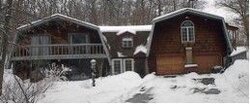Hello all
I live near Burlington, Vermont in an average 1970's home and we burn about 2-3 cords per year and some propane to heat our 2,000 sq. ft. home. We are planning to build a highly energy efficient, very well sealed, highly insulated (R-25 walls, R-42 roof), energy efficient windows, and a heat recovery ventilator. We would like to use a wood stove for most of our heat and was wondering what size woodshed to build immediately adjacent to the room with the wood stove. I was considering a shed to hold 4 cords in two sectioned areas so we could buy green in the spring to dry for 18 months before burning and plan on burning about 2 cords per year.
I was wondering if anyone else out there is burning wood in a highly energy efficient home and how much they're burning.
I spoke with one guy locally that is in a tight home and he said he only burns about a cord per year.
Any comments would be appreciated.
I live near Burlington, Vermont in an average 1970's home and we burn about 2-3 cords per year and some propane to heat our 2,000 sq. ft. home. We are planning to build a highly energy efficient, very well sealed, highly insulated (R-25 walls, R-42 roof), energy efficient windows, and a heat recovery ventilator. We would like to use a wood stove for most of our heat and was wondering what size woodshed to build immediately adjacent to the room with the wood stove. I was considering a shed to hold 4 cords in two sectioned areas so we could buy green in the spring to dry for 18 months before burning and plan on burning about 2 cords per year.
I was wondering if anyone else out there is burning wood in a highly energy efficient home and how much they're burning.
I spoke with one guy locally that is in a tight home and he said he only burns about a cord per year.
Any comments would be appreciated.



